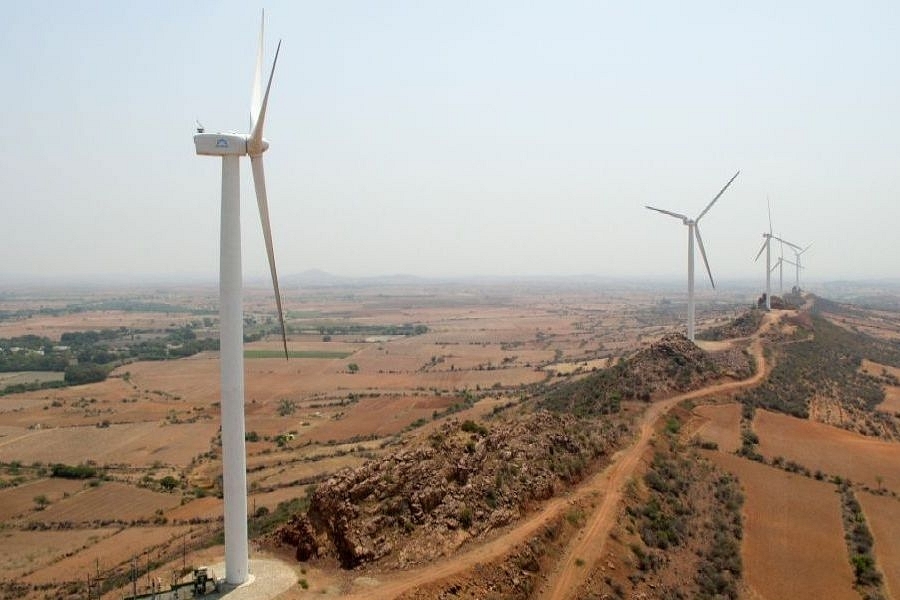Business
Explained: Why The Wind Energy Sector In India Is Facing Headwinds
- Low tariffs and trouble in sourcing energy equipment (especially turbines) is posing serious challenge to India's wind energy sector

A wind energy farm in Rajasthan. (Energy Business Review)
Back in 2017 and 2018, it was not uncommon to read stories about the lowest prices of wind energy being discovered through reverse auctions in India. The record low tariffs were touted as the path to a coal-free future for India.
The Solar Energy Corporation of India (SECI) has been responsible for conducting these auctions since 2017. Previously, the government considered the sector to be nascent and allowed renewable power generators to sell to distribution companies through high tariff power purchase agreements that guaranteed a decent rate of return for investors. However, as the sector matured, auctions were by SECI conducted to shortlist candidates who bid for the lowest tariffs and met the necessary requirements.
With intense competition for setting up wind and solar farms, the prices discovered during the auction continually decreased. According to a Suzlon presentation, we can clearly see that wind power tariffs continually fell from Rs 3.47/Kwh discovered in the SECI 1 bid to around 2.44 during the SECI 3 auctions for wind power.
Since 2017, SECI has managed to auction around 16,300 MW of wind capacity through 11 rounds, but just 3126 MW of power has come on board so far. Further, according to the Indian Wind Turbine Manufacturers’ Association (IWTMA) the unviable auction prices could ensure another 3000-4000 MW could be surrendered as well. The low tariffs shown above mean that prices for construction, operation and maintenance had to be lower as well, for the owners to earn a decent return on the invested funds.
Between FY16 to FY18, India added 10559 MW of installed capacity in the wind sector. However, between FY19 and FY21, it has added only 4379 MW of wind power. The association has also said that the current structure for bidding should be changed as low prices make wind power projects viable only in certain windy states like Gujarat and Tamil Nadu.
Wind farms are owned by power producers/investors who invest in the land, and equipment and bear all the operating costs. The wind farms, in turn, are often installed, operated and run by wind turbine producers. During the 2017 to 2018 period, these power producers were assured of low turbine prices, based on which they bid for lower tariffs. However, the installation has lagged allocation as wind turbine producers have been reneging on their promises of low-priced equipment.
As commodity prices rise, wind turbine manufacturers are finding it more economical to cancel a contract and pay extra charges rather than proceeding with the low prices decided on earlier. For instance, India’s biggest renewable energy company, ReNew Power decided to surrender 400 MW of capacity, because turbine manufacturer Siemens Gamesa backed out of its supply commitment.
Another related challenge is turbine manufacturers located in India shifting their focus from the domestic markets to exports.
While the tariffs cannot be changed, the underlying cost dynamics have changed, resulting in wind energy players surrendering capacity.
In addition, power producers who received allocation have faced problems acquiring land and the right of way for the transmission lines. Once a wind farm is built, it needs to be connected to the grid in order to begin supplying electricity. The longer a farm stays unconnected to the grid, the longer it will take for the asset owners to recover money.
A wind farm with no long-term purchase agreement is not entitled to grid access yet, creating another disincentive for players who wish to set up a plant and sell directly on the exchanges. Nevertheless, with the Central Electricity Regulatory Commission looking to allow General Network Access (GNA), that will make producing and drawing power more flexible. Players who do not have long-term PPAs previously found it difficult to access the grid, and the application for grid connectivity required long-term PPAs. However, in case GNA is implemented, wind farms that have no PPA can join the grid as well – which could spur heavier investments in wind energy. The modification would allow India’s short-term energy market, which currently forms a small part of the overall energy trading market.
The issues faced by the power producers show that the tariffs were extremely low and unviable in light of the high commodity prices today. A higher than envisaged initial investment would mean lower returns for the owners of the wind farms. India has been striving to grow its renewable energy base, but in case these issues persist for a longer time, India’s renewable plans could be in jeopardy.
Introducing ElectionsHQ + 50 Ground Reports Project
The 2024 elections might seem easy to guess, but there are some important questions that shouldn't be missed.
Do freebies still sway voters? Do people prioritise infrastructure when voting? How will Punjab vote?
The answers to these questions provide great insights into where we, as a country, are headed in the years to come.
Swarajya is starting a project with an aim to do 50 solid ground stories and a smart commentary service on WhatsApp, a one-of-a-kind. We'd love your support during this election season.
Click below to contribute.
Latest